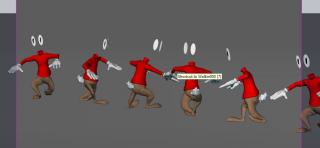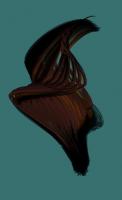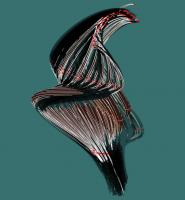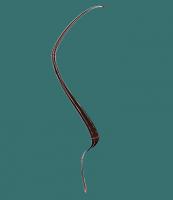-
Posts
21,649 -
Joined
-
Last visited
-
Days Won
119
Content Type
Profiles
Forums
Events
Everything posted by Rodney
-
This was a fun one. This 'Crowdy Knights' exploration returns me to a project I wanted to do when I first picked up Animation:Master. I wasn't smart enough to create the crowd effects back then but perhaps it is time to try again. The project file is included as an attachment in the PDF file. A few notes: Scroll through the pages with mouse or arrow keys to see the animation. Observe the automatic staggering of the run cycle on the different knights. This Action offset is set in the Flocking/Crowd/Swarm properties. The setup is very simple: One Chor One Character (Knight) One Action (Run) Not all frames are in the document (every other frame is shown). The effect is set to display the multiple models as dots in the Chor. I did this mainly to cut down on slowness of response when I ramped the number of Knights up to 50 for a little while. As flocking is a particle effect... make sure you have particles set to 'On'. Scroll through the pages with mouse or arrow keys to see the animation. Added: I don't think most online PDF browsers/viewers allow you to see and access the attachment. For that you have to download the PDF file. CrowdyNights__wAttachment_.pdf
-
I went spelunking for my copy of 'Animation Crash Course' by Eric Goldberg because I recall some nice suggestions on blur in that book. Sadly, I didn't find it so I cannot confirm. I believe the key to good blur here is going to be persistence of shape even though the motion is blurred. The idea is core and very basic to animation in that... Let's say we have three frames of animation - Starting Position - Ending Position - Breakdown or Inbetween Depending on your stylistic goal you will mostly likely need to include one frame that captures all of those three frames in one to achieve the proper smear/smudge/blur. The late Michael Sporn has a variety of examples online to include some stills from Chuck Jone's classic (and majorly blurred) classic 'Dover Boys'. Article: http://www.michaelspornanimation.com/splog/?p=2927 Note that in this article there is a recipe of sorts for CG blur used in Disney's 'Raphunzel'. In the scene (where the character opens and pops quickly through a door) he says: He then follows this up with a nice Timing Chart that accounts for the 17 frame sequence of animation. Disclaimer: It should be noted that Michael is suggesting that Disney over did the blurring in 'Raphunzel' and that made the film entirely too cartoony. The point being that blur works best with cartoon/exaggerated motion. Example image: In the context of a single frame the image looks terribly wrong but when put in motion the effect is (literally and figuratively) transforming. In order to achieve this effect in animation we usually have to either replace the model with a different deformed shape (a copy of the model changed to meet the requirement) or distort the model to account for the perceived motion. At 24 or 30 fps there simply aren't enough frames to capture that fast a motion.
-
There are so many possibilities my head is spinning (and I'm learning new things testing the possibilities so I thank you for your question!) In line with what Robert suggests... Let's assume that you want to create a crowd (initially of the same character but later replacing some as the need fits). If all your characters have a Pose named 'Hit their mark' and that is set to 'On' you could save that out from an Action and then Import and Duplicate via the Multiple Models plugin. (Note: There is a plugin or setting that allows for varying actions but I don't see that at the moment). Open that 'in motion' model and add it to the Chor. When multiplying the model stagger them to the left or right via the Translate option and also rotate them on the Y axis to get a different view of the pose. To organize your crowd you can create folders and drag and drop randomly (or purposefully) selected characters into those folders. This can be handy for later editing as you may want to have one group of people in the crowd 'screaming' while others are 'docile', 'weeping', whatever. If you want to really up the ante then you can use Flocking to drive multiple models in a Chor. This is especially useful if you want to have characters move and yet avoid one another. Some careful consideration must be made when creating actions for the crowd to perform and again organization is key. Several different crowds/flocks can be set up to drive different performances. Added: It also occurs to me that we can fake many an action. For instance, in the attached image I've used one action to drive what at a glance looks to be different movement by multiple characters when in fact it is just the same character/setup rotated and translated. And of course, if the character hasn't hit their mark we can go in and adjust them into their proper place/pose. And best of all... all this takes is a few minutes working between an Action Window (to create the initial pose setup) and in the Chor (to duplicate and modify our stage/performance).
-
There are many different approaches depending on your target/goal so.... not enough info at this point. Are these static poses or are they in the midst of an animated movement? Most definitely yes.
-
Very nice and concise Robert!
-
Here's a link to one of the lego models in A:M Exchange: http://www.hash.com/forums/index.php?showt...017&hl=lego It's been awhile since I've used any CAD programs but by themselves I've never seen them animate things like this: pzTisU5fJrQ Of course there are applications that are specifically built for creating legos!
-
Most CAD programs excel at drafting with precision. As such, if you know precise measurements you'd be well served to create your shapes in CAD and then export them to A:M. In A:M then simply import the Models as Props. This isn't to say that A:M can't create very precise mechanical shapes but only that CAD programs are designed with tools for such static shape precision in mind from the beginning. Most CAD programs do not do well at creating animatable characters and organic shapes. For those you'd want to create them in A:M and then export them to AutoCAD (or the CAD program of your choice. Whereas the most animation you are likely to get out of a CAD progam is a walkthrough A:M is designed for full articulation and animation. There are several new tools in A:M that increase precision such as the Snap to Surface, Snap to Group and Snap to Control Point methods. A tool you won't have in A:M and a lot of CAD programs is the tool that cuts, welds and overlays shapes. But you can create those shapes in any vector (besier) drawing program such as CorelDraw and Adobe Illustrator. Both Corel and Adobe have created a slew of programs to augment and push that technology further. Taking your lego example, several impressive animations have been created with lego pieces and there are lego models available in the A:M Exchange forum. You can create those in approx. 5 seconds by dragging and dropping the models into A:M or (once added to your Library) from your Library panel into a workspace window. The biggest difference is probably price. With the exception of free CAD programs you'll pay considerably more for a CAD program because tolerances are much tighter in the precision modeling and manufacturing world. To achieve the best of both worlds use both A:M and the CAD program of your choice.
-
Yeah, that last one isn't reading that the feet/legs are what is being blurred. It's like something has been superimposed on top of the running. For the effect as I am seeing it play out in my head I don't think you want to approach this so much from a moving sequence perspective but rather one of still imagery. In each frame the multiple images of fee/legs should be clear and readable. It's the inbetweening then that gets the blur effect. Suggestion: Render out a sequence with static imagery showing exactly where the (multiple) feet and legs are to be placed (note that this will likely NOT play as well as a moving image at this stage). Now setup a Chor with that sequence as a Rotoscope or Layer and render that sequence again with Multipass on (higher levels should be better) and blur effects on as well. Note that what you are doing here (or can be doing) is basically retiming the animation so you may want to render a longer sequence in the first step than what you will be targetting for length in the second. Where the magic kicks in is where you adjust your keyframes and timing so that on the frames you wish to be blurred more than one keyframe is set on a frame that will be rendered (this will guarantee more blur during those frames. Consideration should also go for manual blur effects such as elongating or deforming the mesh itself so that the renderer has more to use in the blurring effect. Working from a known set of prerendered images can yield better (and more controllable) blur effects than if we render using the actual geometry. The beauty of blurring rendered images is that if you use copies of your image sequence rather than the original files you can easily set the project up again and render with a different effect. A quick way to duplicate the sequence being to copy/paste the folder that contains the images to another folder and then rename the folder. I like to use a folder named 'RenderFolder' as my target folder as I can then simply duplicate that folder and then render right over the top of the old imagery. This can have an added benefit if I only need to rerender specific frames of a given animation. It's like filling thousands of glasses with colored water and keeping them full and precisely the color desired... some may not need to be filled repeatedly or their color changed while others may. In this way if there is a 'perfect frame' that you know you want to read clearly in the sequence you can keep that outside the render que and replace any other image that tries to take its place. Hope that isn't too esoteric.
-
I haven't spent a lot of time trying to turn off/on decals but there are several approaches and several shortcuts you can take depending on the complexity and setup of your project. Thought 1 Use a filter to show all decals in one tab of the Project Workspace. We can filter for Types and words so that specific criteria for what we want to view on the active tab is shown. For instance we can name a decal or shortcut a specific name intentionally so that the filter will grab them or place them in a folder that can further differentiate location and status (i.e. adding 'Decal On' or 'Decal Off' to the actual name. Thought 2 Sequential Decals with Transparent frames (A bit more esoteric but could work very well in some cases) Let's say we know that a particular decal needs to 'disappear' for 20 frames out of a 300 frame sequence or fade in/fade out and we don't want to manually set hundreds or thousands of shortcuts to the same image sequence that is repeated over and over again on multiple models. One solution might be to replace those 20 frames with transparent images (i.e remove the image and leave only the Alpha Channel). It helps in the case of this second one if you know exactly how many frames a sequence is and then replace the files in the sequence accordingly. Care should be taken to make sure the file resolution/size remains constant because any change can (and likely will) interupt the playback of the sequence. Depending on the specific project there may be better ways (such as the Pose controller Robert mentions) You could setup up a controller for instance that turns some, many or all decals off (or all of the previous) at different percentages of a Pose slider. Edit: It occurs to me that you could have one decal applied to all bricks and then have that present itself sequentially. In Photoshop you'd basically have the master layer show what will commonly be seen and then as each brick changes export/save that new image out into a sequential series of images to play out in the animation. These are more 'hacking' methodologies than straightforward toggle on/off but anything that works and works well might be worth investigating.
-
I'm glad he went to the hospital. Some things you cannot put off. Hope you have a speedy recovery! If anyone knows where he was admitted perhaps we can send him some eCards. Most hospitals have those.
-
Yes, indeed. I think it's cool. Although I'm sure there are other ways as well. If the mesh is also simcloth... hmmm, that might be even cooler. It's been awhile since I did anything serious with cloth but my memory recalls using the friction setting a lot to control the flow of the cloth mesh. There are also force, and bending(?) angle settings that I found I had to adjust to get decent (and controlled) movement.
-
I just returned from work so am about to get some sleep. If he's not got himself pulled together by later this afternoon I might have time to put him together. Weekends are rough on my splining time these days.
-
hehe. I'm thinking we are pretty close to having this guy put together.
-
Okay Jack. You've officially used your quota of emoticons for the week. Silly human. Everyone knows that snowmen don't have hair. Nice work Mark!
-
A problem with chasing realistic hair is that real hair doesn't always move as we want it to either. The folks at Disney and other companies have spent enormous amounts of money to get where they are now and their latest efforts haven't been in creating realistic hair but rather hair that can be artistically directed. To me this boils down to returning to the basics of animation where we have a starting point... our origin (key) and an ending point... goal or target (key) and the means of getting from A to B... the path or performance (breakdown). These three key poses are then inbetween rather mechanically because to do anything else would be to end up with results exactly as you are seeing with the simulation... unintended results on random frames. What this means is that our inbetweener (the computer) is dictating those inbetweens for us when (in most cases) we haven't given it the required information (two extreme drawings and a breakdown). Can we get there with particle hair? Yes, I think so but at this stage I know I'm not ready for it because I don't know enough about animating hair the mechanical way to begin to understand what the computer is doing with the information. I have a few (untested) theories but only time will prove whether they are worth anything. With mesh hair the easiest way to animate it is to create those key poses (where does the hair shape begin... where does it end... how does it travel from the beginning point to the end) and then make sure the computer is properly inbetweening them. If ideally set most hair movement should only take about five or six keyframes (initial position, anticipation, primary action...overlapping action... secondary action, followthrough, settling). If I were to suggest that we can control long (mesh-based) hair by manipulating the CPs on a three or four CPs control spline... would you believe me?
-
Looking good! I like your spline placement.
-
Be careful, I'm considering doing more of it! Most of my doodles have a few goals behind them. In this case I believe they were: - Olaf is a cool character. It'd be fun to model him. - He looks easy to model. - It shouldn't take much time to model him. - Dan is doing that Disney eye thing over there. How would I approach the cartoon Disney eye look on Olaf? That's about all the motivation I needed in this case. Results: - Olaf is still a very cool character and I'm pleased I was able to capture his likeness. - He's not as easy to model as he seems. - It would take a good day to model him correctly in my estimation. (This likely wouldn't include texturing and rigging... allot at least one day more for each) - Dan is moving in closer to capturing that Disney look! - Olaf's cheek area is the primary area of interest that would take the most time for me to accurately model. That might have to be tweaked considerably due to the exaggerated expressions he makes. - Boolean cutters for eye sockets and mouth work well for a POC but there really is no substitute for modeling those features in. - Some other observations I'm forgetting. Jack, If you are interested in modeling Olaf further I'm not opposed to continuing the WIP here as long as there is sustained interest. He got to the point where I had satisfied my curiosity and I have no other plans for him beyond that. These WIPs are a great place to compare notes, improve models, etc. Perhaps we can try his big ugly snowbrother next.
-
I figure in a couple hundred years we'll have every character ever created in the A:M Exchange readily available for downloading. (By then the world will have moved on to a different copyrighting/intellectual property system)
-
I don't think you'd want this model as it isn't ready for prime time yet. Having said that I'm willing to upload it as it might provide a starting place for a proper modeling of the character (or one like him) to begin. You have been warned. My doodles are merely proof of concepts and not even wanna be 'models' yet. If you replace everything in the model with new splineage... I believe you'll have a proper Olaf. Olaf.mdl
-
Jack (of JackDrama fame) gratiously offered to share his model of a woman in Roger Reynolds's 'Phillies Diner' topic. He mentioned something about rendering wireframes of final modifications and such and rather than clutter Roger's topic here's is a shiny new topic for others to post their mods. Thanks for sharing Jack! Original Woman Model Exact same model with one Named Group added to give her a black skin tight suit ***Note: You'll want to Right Click and save these as 'Woman.mdl' or other appropriate name with the extension .mdl as they will otherwise open as text files in your browser.***
-
Nothing to forgive. You should see my list of things I wish A:M could do. At least the things you identify would be worthy contenders. Mine would be classified more as fits of laziness. Here's an example: I wish A:M would 'render' to PDF. Why? Because then I wouldn't have to exit A:M to convert images rendered in other formats to PDF.
-
Sad news for animation fans and especially for those that followed his blog (splog). Michael Sporn died on 19 Jan after a three year battle with pancreatic cancer. Michael Barrier has a bio up on his career on his blog. http://michaelbarrier.com/Home%20Page/What...elsporn19462014 It isn't clear what will be done with his blog and it hasn't been online for some time. Michael had amassed a considerable amount of history and commentary on animation that was greatly appreciated by followers of animation.
-
-
I won't suggest this as a style for you to shoot for but I thought it was an interesting result. It almost looks painterly in a way. The only image applied was a flat gray image used to slightly increase the size of the geometry via displacement. The second image is the shaded wireframe view. The third image is an example of one of the single strand that was duplicated. (To make the strands I duplicated a bunch of single splines and then used Sweeper to sweep a five CP circle along their all of the spline paths. The idea being that you could lay individual splines down from a head as guides and then use Sweeper to actually create the hair. After the hair is in place either remove the guides or leave them there... some of the guides could even be 'rendered as lines' to indicate stray hairs)
-
That may be the case but you've done an impressive job!

















